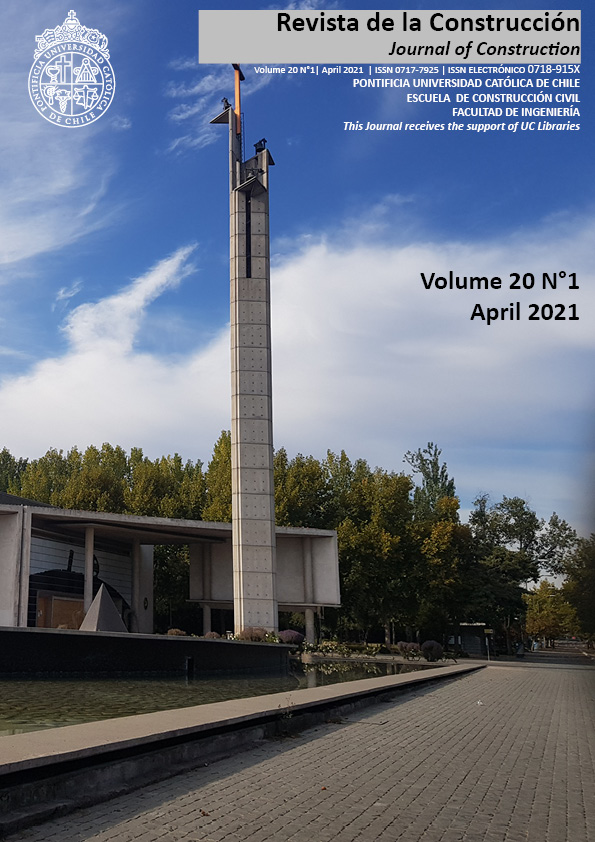Dynamic properties of steel structures under different construction stages, ambient temperature and live load
DOI:
https://doi.org/10.7764/RDLC.20.1.163Keywords:
dynamic properties, construction stages, ambient temperature, operational modal analysis, steel buildingsAbstract
Operational modal analysis (OMA), assessing the effect of environmental conditions on the structures has been attracting widespread interest and its results have been used for the validation of numerical models. This paper aims to validate the application of OMA on steel buildings to investigate their dynamic behavior during and after their construction. In this context, the construction stages of a steel building were monitored. With the completion of the construction, the dynamic tests were applied at different times to identify the changes in the modal characteristics of the building with respect to the temperature and service loads. Finally, the analytical model of the building was performed and the building’s dynamic properties were determined numerically. As a result, the experimentally obtained dynamic properties for the completed building were compared to those derived from numerical analysis. The results underlined the importance of slab construction for the formation of building behavior in the construction stages. Besides the effects of ambient temperature and service load on the dynamic properties of steel buildings were revealed. Finally, the lack of partition walls in the numerical model has been grasped as the main reason behind the differences between the experimentally and numerically obtained dynamic properties.
Downloads
References
Aras, F. (2016). Frequency variation in construction stages and model validation for steel buildings. Steel and Composite Structures, 22(3), 647-662. https://doi.org/10.12989/scs.2016.22.3.647
Aras, F. (2016). Ambient and forced vibration testing with numerical identification for RC buildings. Earthquake and Structures, 11(5), 809-822. https://doi.org/10.12989/eas.2016.11.5.809
Bayraktar, A., Sevim, B., Altunışık, A.C., Türker, T. & Adanur, S. (2008). Determination of blast vibration effects on the dynamic behaviour of the highway bridges using modal testing. 8th International Congress in Advances in Civil Engineering, Famagusta, North-Cyprus, 15-17 September 2008.
Brincker, R., Ventura, C., & Andersen, P. (2003, February). Why output-only modal testing is a desirable tool for a wide range of practical applications. In Proc. International Modal Analysis Conference (IMAC) XXI, paper (Vol. 265), Kissimmee, Florida.
Brincker, R. & Ventura, C. (2015). Introduction to operational modal analysis. Chichester, United Kingdom: John Wiley & Sons Ltd.
Chellini, G., De Roeck, G., Nardini, L. & Salvatore, W. (2010). Damage analysis of a steel-concrete composite frame by finite element model updating. Journal of Constructional Steel Research, 66, 398-411. https://doi.org/10.1016/j.jcsr.2009.10.004
Consuegra, F.A. & Santos, C. (2015). Vibration analyses for the local and global evaluation of bridges as a tool for structural retrofit. Revista de la Construccion, 14(1), 16-22. https://doi.org/10.4067/S0718-915X2015000100002
Gentile, C., Saisi, A. & Cabboi, A. (2015). Structural identification of a masonry tower based on operational modal analysis. International Journal of Architectural Heritage, 9(2), 98-110. https://doi.org/10.1080/15583058.2014.951792
Inman, D.J. (2013). Engineering Vibration – 4th Edition. Prentice Hall, New Jersey.
Kudu, F.N., Uçak, Ş., Osmancikli, G., Türker, T. & Bayraktar, A. (2015). Estimation of damping ratios of steel structures by Operational Modal Analysis method. Journal of Constructional Steel Research, 112, 61-68. https://doi.org/10.1016/j.jcsr.2015.04.019
Macdonald, J.H.G. & Daniell, W.E. (2005). Variation of modal parameters of a cable-stayed bridge identified from ambient vibration measurements and FE modeling. Engineering Structures, 27, 1916-1930. https://doi.org/10.1016/j.engstruct.2005.06.007
Min, Z.H. & Sun, L.M. (2013). Wavelet-based structural modal parameter identification. Structural Control Health Monitoring, 20, 121-138. https://doi.org/10.1002/stc.474
Ni, Y.C., Lu, X.L. & Lu, W.S. (2017). Operational modal analysis of a high‐rise multi‐function building with dampers by a Bayesian approach. Mechanical Systems and Signal Processing, 86, 286-307. https://doi.org/10.1016/j.ymssp.2016.10.009
Peeters, B. & De Roeck, G. (2001). Stochastic system identification for operational modal analysis: a review. Journal of dynamic systems measurement and control-transactions of the ASME, 123(4), 659-667. https://doi.org/10.1115/1.1410370
Sevim, B., Altunışık, A.C. & Bayraktar, A. (2012). Earthquake behavior of Berke arch dam using ambient vibration test results. Journal of Performance of Constructed Facilities, 26(6), 780-792. https://doi.org/10.1061/(ASCE)CF.1943-5509.0000264
Shakib, H. & Parsaeifard, N. (2011). Ambient vibration tests on a 19-story asymmetric steel building. Structural Engineering and Mechanics, 40(1), 1-11. https://doi.org/10.12989/sem.2011.40.1.001
Shiradhonkar, S.R. & Shrikhande, M. (2011). Seismic damage detection in a building frame via finite element model updating. Computers & Structures, 89(23-24), 2425-2438. https://doi.org/10.1016/j.compstruc.2011.06.006
Torkamani, M.A.M. & Ahmadi, A.K. (1988). Stiffness identification of a tall building during construction period using ambient tests. Earthquake Engineering Structural Dynamics, 16(8), 1177-1188. https://doi.org/10.1002/eqe.4290160806
Türker, T., Kartal, M.E., Bayraktar, A. & Muvafik, M. (2009). Assessment of semi-rigid connections in steel structures by modal testing. Journal of Constructional Steel Research, 65, 1538-1547. https://doi.org/10.1016/j.jcsr.2009.03.002
Türker, T. & Bayraktar, A. (2011). Experimental and numerical investigation of brace configuration effects on steel structures. Journal of Constructional Steel Research, 67, 854-865. https://doi.org/10.1016/j.jcsr.2010.12.008
Türker, T. & Bayraktar, A. (2013). Finite element model calibration of steel frame buildings with and without brace. Journal of Constructional Steel Research, 90, 164-173. https://doi.org/10.1016/j.jcsr.2013.08.003
Zhang, F., Yang, Y., Xiong, H., Yang, J. & Yu, Z. (2019). Structural health monitoring of a 250‐m super‐tall building and operational modal analysis using the fast Bayesian FFT method. Structural Control Health Monitoring, 26(8), e2383. https://doi.org/10.1002/stc.2383








